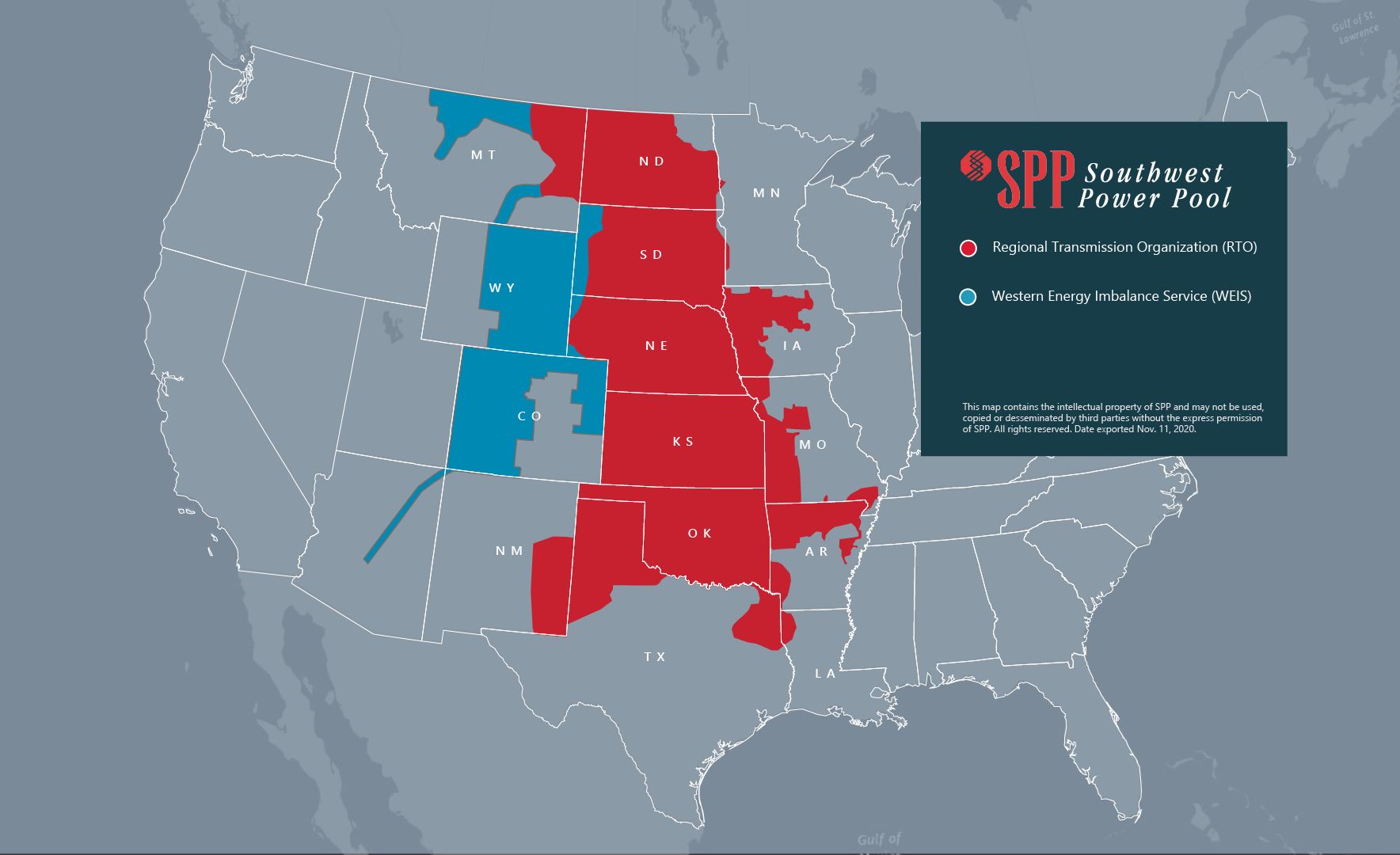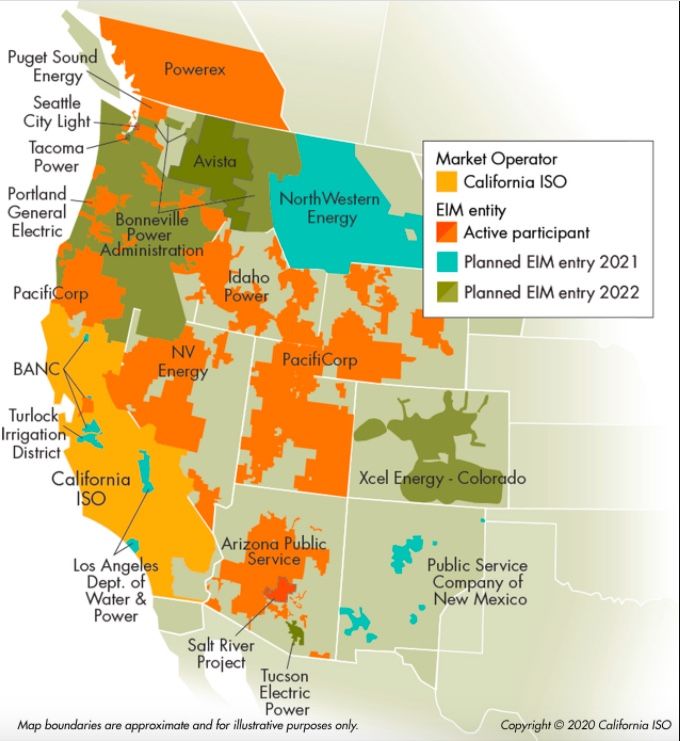Interstate grid operator Southwest Power Pool has expanded its wholesale energy market, the latest step in a series of nationwide moves aimed at bringing more efficiency to parts of the country rich in renewable energy potential but lacking in the energy trading regimes to make the best use of it.
Monday’s launch of SPP’s Western Energy Imbalance Service Market will bring real-time energy-balancing trading activity to eight utilities and transmission authorities across Colorado, Wyoming, Montana, South Dakota and Nebraska.
These regions have some of the best wind power resources in the country and are seeing a massive growth of wind farms to take advantage of it. But like other parts of the country with fast-growing renewables, they can struggle to integrate wind power into the bilateral arrangements they've previously relied on to balance generation capacity with electricity demand across their interconnected transmission systems.

The Western Energy Imbalance Service Market doesn’t bring the full range of day-ahead energy trading or transmission planning coordination that SPP manages for utilities across its existing footprint spanning 17 states. But it is expected to lower wholesale energy costs and reduce transmission congestion to the tune of about $49 million per year, according to a recent Brattle Group study. Participants include Basin Electric Power Cooperative, Deseret Power Electric Cooperative, the Municipal Energy Agency of Nebraska, Tri-State Generation and Transmission Association, the Wyoming Municipal Power Agency, and two balancing authority footprints of the federal power marketing organization Western Area Power Administration.
Expanding energy markets across the country
That same logic has driven the expansion of California grid operator CAISO’s Western Energy Imbalance Market (EIM), another voluntary real-time energy trading market. Since 2014, the Western EIM has expanded to more than a dozen utilities including PacifiCorp, Arizona Public Service, NV Energy, Portland General Electric, Puget Sound Energy, Seattle City Light, Salt River Project and, most recently, Xcel Energy Colorado.
CAISO's EIM has provided about $1.2 billion in cumulative benefits over the past six years, according to a January report. One of the EIM's key benefits has been creating more fluid markets for trading the region’s growing share of wind and solar power that would have otherwise been curtailed due to lack of demand to absorb it.

This renewable integration value is the main reason that states, utilities and large-scale electricity buyers with clean energy goals have been pushing for expanding wholesale energy markets in regions that now lack federally regulated regional transmission organizations (RTOs) and independent system operators (ISOs). The biggest such region is the Western U.S., with 39 separate balancing authorities that now conduct bilateral trades across transmission networks built outside regional planning and cost-sharing regimes.
In the Southeast, the other major region without a regional grid operator, utilities including Duke Energy, Dominion Energy, Southern Company and the federal Tennessee Valley Authority have launched the Southeast Energy Exchange Market initiative.

At the same time, CAISO is in the process of stakeholder outreach for an extended day-ahead market that would add day-ahead energy trading to EIM’s real-time operations. That could encompass a far greater portion of the overall electricity trading activity across regional wholesale markets, with larger commensurate benefits.
A starting point for nationwide grid integration?
Some stakeholders are calling for even broader market integration, however, encompassing not only energy trading but also planning and cost-sharing for generation capacity and transmission across the West and Southeast. Last month, 36 of the country’s largest corporations including Amazon, Google, Microsoft, General Motors, Johnson & Johnson and McDonald's signed a clean energy policy statement from the Renewable Energy Buyers Alliance that put expanding wholesale energy markets at the top of its agenda.
Advanced Energy Economy (AEE), another group representing companies with aggressive clean energy goals, has also made expanded regional markets a key policy priority. Going beyond voluntary energy trading regimes to more fully integrated structures is particularly important to create structures for building the transmission networks needed to carry wind and solar power from remote regions to population centers.
“This has been a decades-long discussion,” Amisha Rai, AEE managing director, said in a recent interview. “You have multiple states looking to establish a clean energy grid. It’s a regional challenge that requires a regional approach.”
CAISO and then-California Gov. Jerry Brown had proposed just this type of pan-Western market during the mid-2010s, highlighting the far greater cost savings and efficiencies it could deliver. A 2016 report from The Brattle Group found full market integration could deliver $1 billion to $1.5 billion per year by 2030 for California ratepayers alone, stemming primarily from expanded transmission and market reach to pull renewable energy from across the region to help meet the state’s zero-carbon goals. And a U.S. Energy Department-sponsored study indicated that a regionwide RTO could save more than $1.2 billion per year in electricity costs.
But that effort failed in the California legislature under pressure from opponents worried about out-of-state utilities failing to deliver on clean energy growth or moving renewable energy jobs out of state. Another concern was that expanding CAISO’s market beyond the state’s borders could subject it to regulatory interference from the Trump administration’s appointees to the Federal Energy Regulatory Commission, which regulates ISOs and RTOs.
Getting utilities, state lawmakers and regulators to agree on the governance structures for broader market integration "comes with major challenges,” Rai said. “A lot of that, I think, requires governors and administrators to engage and provide direct guidance, and key decision-makers in the state to prioritize economic development, as well as the public ratepayer benefits that are tied to the development of an RTO.”
At the same time, the Biden-Harris administration’s focus on policies to spur clean energy, and the shift from Republican to Democratic leadership at FERC, has allayed concerns from states with clean energy mandates.
“What I’m looking forward to is a constructive federal-state relationship with this,” Rai said. “If the regions are able to prosper and figure out a robust pathway to a 100 percent clean grid, that’s going to benefit the nation as a whole from an economic development standpoint.”




